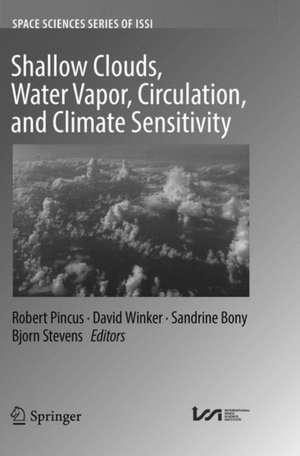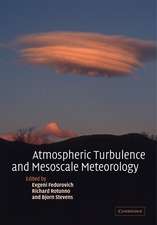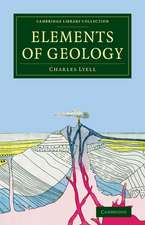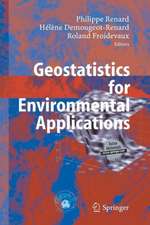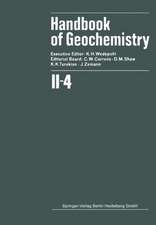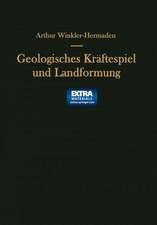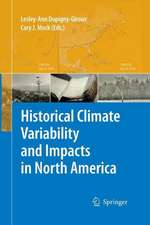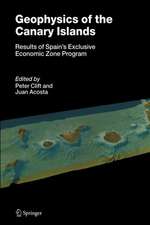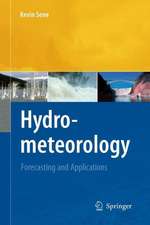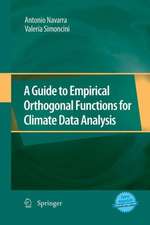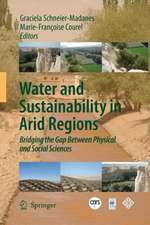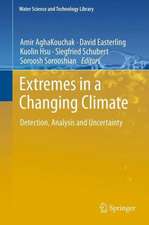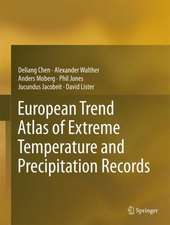Shallow Clouds, Water Vapor, Circulation, and Climate Sensitivity: Space Sciences Series of ISSI, cartea 65
Editat de Robert Pincus, David Winker, Sandrine Bony, Bjorn Stevensen Limba Engleză Paperback – feb 2019
This volume presents a series of overview articles arising from a workshop exploring the links among shallow clouds, water vapor, circulation, and climate sensitivity. It provides a state-of-the art synthesis of understanding about the coupling of clouds and water vapor to the large-scale circulation. The emphasis is on two phenomena, namely the self-aggregation of deep convection and interactions between low clouds and the large-scale environment, with direct links to the sensitivity of climate to radiative perturbations. Each subject is approached using simulations, observations, and synthesizing theory; particular attention is paid to opportunities offered by new remote-sensing technologies, some still prospective. The collection provides a thorough grounding in topics representing one of the World Climate Research Program’s Grand Challenges.
Previously published in Surveys in Geophysics, Volume 38, Issue 6, 2017
The aritcles “Observing Convective Aggregation”, “An Observational View of Relationships Between Moisture Aggregation, Cloud, and Radiative Heating Profiles”, “Implications of Warm Rain in Shallow Cumulus and Congestus Clouds for Large-Scale Circulations”, “A Survey of Precipitation-Induced Atmospheric Cold Pools over Oceans and Their Interactions with the Larger-Scale Environment”, “Low-Cloud Feedbacks from Cloud-Controlling Factors: A Review”, “Mechanisms and Model Diversity of Trade-Wind Shallow Cumulus Cloud Feedbacks: A Review”, “Structure and Dynamical Influence of Water Vapor in the Lower Tropical Troposphere”, “Emerging Technologies and Synergies for Airborne and Space-Based Measurements of Water Vapor Profiles”, “Observational Constraints on Cloud Feedbacks: The Role of Active Satellite Sensors”, and “EUREC4A: A Field Campaign to Elucidate the Couplings Between Clouds, Convection and Circulation” are available as open access articles under a CC BY 4.0 license at link.springer.com.
| Toate formatele și edițiile | Preț | Express |
|---|---|---|
| Paperback (1) | 692.09 lei 38-44 zile | |
| Springer International Publishing – feb 2019 | 692.09 lei 38-44 zile | |
| Hardback (1) | 908.36 lei 3-5 săpt. | |
| Springer International Publishing – 12 iun 2018 | 908.36 lei 3-5 săpt. |
Din seria Space Sciences Series of ISSI
- 15%
 Preț: 654.30 lei
Preț: 654.30 lei - 18%
 Preț: 1019.49 lei
Preț: 1019.49 lei - 15%
 Preț: 647.27 lei
Preț: 647.27 lei - 18%
 Preț: 959.50 lei
Preț: 959.50 lei - 18%
 Preț: 1406.98 lei
Preț: 1406.98 lei - 18%
 Preț: 904.91 lei
Preț: 904.91 lei - 18%
 Preț: 1123.35 lei
Preț: 1123.35 lei - 18%
 Preț: 908.36 lei
Preț: 908.36 lei - 18%
 Preț: 903.93 lei
Preț: 903.93 lei - 20%
 Preț: 577.35 lei
Preț: 577.35 lei - 18%
 Preț: 1115.46 lei
Preț: 1115.46 lei - 18%
 Preț: 1009.70 lei
Preț: 1009.70 lei - 18%
 Preț: 796.61 lei
Preț: 796.61 lei - 18%
 Preț: 739.81 lei
Preț: 739.81 lei - 18%
 Preț: 899.21 lei
Preț: 899.21 lei - 18%
 Preț: 1126.52 lei
Preț: 1126.52 lei - 18%
 Preț: 1016.01 lei
Preț: 1016.01 lei - 18%
 Preț: 1398.80 lei
Preț: 1398.80 lei - 15%
 Preț: 545.15 lei
Preț: 545.15 lei -
 Preț: 436.35 lei
Preț: 436.35 lei -
 Preț: 430.59 lei
Preț: 430.59 lei - 18%
 Preț: 983.65 lei
Preț: 983.65 lei -
 Preț: 412.78 lei
Preț: 412.78 lei - 18%
 Preț: 956.50 lei
Preț: 956.50 lei - 18%
 Preț: 950.52 lei
Preț: 950.52 lei - 18%
 Preț: 951.29 lei
Preț: 951.29 lei - 24%
 Preț: 1060.10 lei
Preț: 1060.10 lei - 18%
 Preț: 958.88 lei
Preț: 958.88 lei - 24%
 Preț: 788.94 lei
Preț: 788.94 lei - 15%
 Preț: 707.00 lei
Preț: 707.00 lei - 18%
 Preț: 951.59 lei
Preț: 951.59 lei - 24%
 Preț: 1052.14 lei
Preț: 1052.14 lei - 20%
 Preț: 574.08 lei
Preț: 574.08 lei - 18%
 Preț: 964.10 lei
Preț: 964.10 lei - 15%
 Preț: 647.40 lei
Preț: 647.40 lei - 18%
 Preț: 961.55 lei
Preț: 961.55 lei - 18%
 Preț: 964.23 lei
Preț: 964.23 lei
Preț: 692.09 lei
Preț vechi: 910.64 lei
-24% Nou
Puncte Express: 1038
Preț estimativ în valută:
132.43€ • 138.64$ • 109.58£
132.43€ • 138.64$ • 109.58£
Carte tipărită la comandă
Livrare economică 01-07 aprilie
Preluare comenzi: 021 569.72.76
Specificații
ISBN-13: 9783030084158
ISBN-10: 3030084159
Pagini: 396
Ilustrații: VIII, 396 p. 144 illus., 134 illus. in color.
Dimensiuni: 155 x 235 mm
Ediția:Softcover reprint of the original 1st ed. 2018
Editura: Springer International Publishing
Colecția Springer
Seria Space Sciences Series of ISSI
Locul publicării:Cham, Switzerland
ISBN-10: 3030084159
Pagini: 396
Ilustrații: VIII, 396 p. 144 illus., 134 illus. in color.
Dimensiuni: 155 x 235 mm
Ediția:Softcover reprint of the original 1st ed. 2018
Editura: Springer International Publishing
Colecția Springer
Seria Space Sciences Series of ISSI
Locul publicării:Cham, Switzerland
Cuprins
Preface to the Special Issue “ISSI Workshop on Shallow Clouds and Water Vapor, Circulation and Climate Sensitivity”.- 1. Convective Self-Aggregation in Numerical Simulations: A Review.- 2. Observing Convective Aggregation.- 3. An Observational View of Relationships Between Moisture Aggregation, Cloud, and Radiative Heating Profiles.- 4. Correction to: An Observational View of Relationships Between Moisture Aggregation, Cloud, and Radiative Heating Profiles.- 5. Implications of Warm Rain in Shallow Cumulus and Congestus Clouds for Large-Scale Circulations.- 6. A Survey of Precipitation-Induced Atmospheric Cold Pools over Oceans and Their Interactions with the Larger-Scale Environment.- 7. Low-Cloud Feedbacks from Cloud-Controlling Factors: A Review.- 8. Mechanisms and Model Diversity of Trade-Wind Shallow Cumulus Cloud Feedbacks: A Review.- 9. Importance Profiles for Water Vapor.- 10. Structure and Dynamical Influence of Water Vapor in the LowerTropical Troposphere.- 11. The Representation of Tropospheric Water Vapor Over Low-Latitude Oceans in (Re-)analysis: Errors, Impacts, and the Ability to Exploit Current and Prospective Observations.- 12. Airborne Lidar Observations of Water Vapor Variability in Tropical Shallow Convective Environment.- 13. Emerging Technologies and Synergies for Airborne and Space-Based Measurements of Water Vapor Profiles.- 14. Observational Constraints on Cloud Feedbacks: The Role of Active Satellite Sensors.- 15. Shallow Circulations: Relevance and Strategies for Satellite Observation.- 16. EUREC4A: A Field Campaign to Elucidate the Couplings Between Clouds, Convection and Circulation.
Notă biografică
Robert Pincus is a senior research scientist at the Cooperative Institute for Research in Environmental Sciences at the University of Colorado. He works on problems at the nexus of clouds, radiation, and climate ranging from practical questions as to how radiation calculations may be optimally coupled to modeling systems, through efforts aimed at the robust comparison of models and remote sensing observations, to a range of contributions synthesizing how observations of the past and projections of future change can be synthesized.
David Winker is a senior scientist at NASA Langley Research Center and Principal Investigator of the CALIPSO satellite mission. His work focuses on the use of lidar and combined lidar and passive observations to better understand atmospheric aerosols and clouds. His efforts have ranged from the development of space lidar systems and innovative retrieval techniques to the development of global lidar data products tailored to the needs of the climate and operational weather forecast communities. CALIPSO global cloud products have served as benchmark references for the GEWEX Cloud Assessment and for the evaluation of cloud thermodynamic phase in global models, leading to new insights into the behavior of clouds and guiding the improvement of models.
Bjorn Stevens is a director at the Max Planck Institute for Meteorology, where he leads the Atmosphere in the Earth System Department, and a professor at the University of Hamburg. His research, which uses a wide range of methodologies to study how water in the atmosphere influences Earth’s climate, has made important contributions to understanding of how turbulent mixing and cloud microphysical processes influence the structure and organization of clouds. In showing how these processes influence the cloud response to warming, and how radiative forcing responds to aerosol perturbations, his research has proven instrumental for our present comprehension of climate change.
Sandrine Bony is a Director of Research at the National Center for Scientific Research (CNRS) in France, working at the Laboratoire de Météorologie Dynamique (LMD) of Sorbonne University. Her research aims at understanding the role of clouds in climate and in climate change through modeling, observational and theoretical approaches. Her most important contributions include unraveling the physical mechanisms through which clouds respond to climate change and influence climate sensitivity, showing the influence of the organization of tropical convection on climate, and understanding the ways in which clouds and precipitation couple to atmospheric circulations.
Bjorn Stevens is a director at the Max Planck Institute for Meteorology, where he leads the Atmosphere in the Earth System Department, and a professor at the University of Hamburg. His research, which uses a wide range of methodologies to study how water in the atmosphere influences Earth’s climate, has made important contributions to understanding of how turbulent mixing and cloud microphysical processes influence the structure and organization of clouds. In showing how these processes influence the cloud response to warming, and how radiative forcing responds to aerosol perturbations, his research has proven instrumental for our present comprehension of climate change.
Sandrine Bony is a Director of Research at the National Center for Scientific Research (CNRS) in France, working at the Laboratoire de Météorologie Dynamique (LMD) of Sorbonne University. Her research aims at understanding the role of clouds in climate and in climate change through modeling, observational and theoretical approaches. Her most important contributions include unraveling the physical mechanisms through which clouds respond to climate change and influence climate sensitivity, showing the influence of the organization of tropical convection on climate, and understanding the ways in which clouds and precipitation couple to atmospheric circulations.
Textul de pe ultima copertă
This volume presents a series of overview articles arising from a workshop exploring the links among shallow clouds, water vapor, circulation, and climate sensitivity. It provides a state-of-the art synthesis of understanding about the coupling of clouds and water vapor to the large-scale circulation. The emphasis is on two phenomena, namely the self-aggregation of deep convection and interactions between low clouds and the large-scale environment, with direct links to the sensitivity of climate to radiative perturbations. Each subject is approached using simulations, observations, and synthesizing theory; particular attention is paid to opportunities offered by new remote-sensing technologies, some still prospective. The collection provides a thorough grounding in topics representing one of the World Climate Research Program’s Grand Challenges.
Previously published in Surveys in Geophysics, Volume 38, Issue 6, 2017
The articles “Observing Convective Aggregation”, “An Observational View of Relationships Between Moisture Aggregation, Cloud, and Radiative Heating Profiles”, “Implications of Warm Rain in Shallow Cumulus and Congestus Clouds for Large-Scale Circulations”, “A Survey of Precipitation-Induced Atmospheric Cold Pools over Oceans and Their Interactions with the Larger-Scale Environment”, “Low-Cloud Feedbacks from Cloud-Controlling Factors: A Review”, “Mechanisms and Model Diversity of Trade-Wind Shallow Cumulus Cloud Feedbacks: A Review”, “Structure and Dynamical Influence of Water Vapor in the Lower Tropical Troposphere”, “Emerging Technologies and Synergies for Airborne and Space-Based Measurements of Water Vapor Profiles”, “Observational Constraints on Cloud Feedbacks: The Role of Active Satellite Sensors”, and “EUREC4A: A Field Campaign to Elucidate the Couplings Between Clouds, Convection and Circulation” are available as open access articles under a CC BY 4.0 license at link.springer.com.
Caracteristici
Provides a comprehensive view of the role of clouds and water vapor in helping control the past, present, and future large-scale circulations, with impacts on climate sensitivity Includes thorough assessments of current understanding and future opportunities enabled by field experiments, new and prospective technologies, and emerging synthesis and understanding Represents a deep source of cutting-edge information on the topics of convective self-aggregation and low cloud feedbacks Presents a unified view of clouds, water vapor, and circulation informed by observational, theoretical, and modeling approaches
